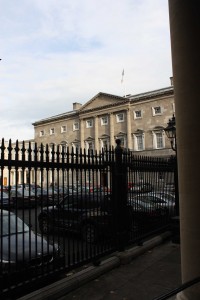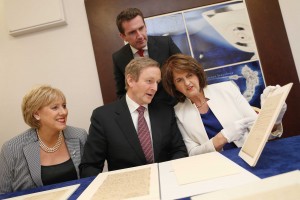Culture in crisis
Published in Issue 3 (May/June 2015), Platform, Volume 23
Leinster House viewed from the National Museum, Kildare Street. Physical proximity to power, beside the Dáil and Seanad, provided little comfort for this flagship cultural body. (©Ardfern)
The National Museum and National Library are nominally autonomous bodies, thought of as staffed mainly by professionals. They are frequently called upon, however, to provide substance for government policy initiatives. The decade of remembrance and the 1916 commemoration is a case in point. The Museum, National Library and other institutions had to ride to the rescue.
On 1 April the Museum announced a year-long programme of 1916-themed events. The date is appropriate, considering the video produced last November to launch the government’s 1916 programme. Patrick Pearse, James Connolly and the other 1916 leaders were not mentioned, but Queen Elizabeth, Bono, David Cameron and Bob Geldof were. An Irish-language translation of the Proclamation on the launch website was from ‘Google translate’, including grammatical and other errors. An unseemly discussion also took place on whether a British royal should take part in 1916 remembrance, threatening (at times) to transform commemoration into re-enactment.
The cultural institutions give political leaders ballast, slowing down or reversing their rush to ridicule. This dual role of attempting to design long-term goals to serve the public and politicians as well as increasing tourist numbers creates its own tensions during the normal course of events.
But the National Museum and Library, and their constituent parts, are in crisis. When recession hit, culture and the poor were made poorer. The minimum wage and minimal provision for our cultural institutions were immediate targets. Physical proximity to power, on either side of the Dáil and Seanad, provided little comfort for these flagship cultural bodies, and less for homeless man Jonathan Corrie, who died in a doorway beside the gates of Leinster House in December 2014.
The comparison seems odious, comparing preserving the life of a human being with the preservation of dead things. But the books, manuscripts, documents and artefacts that are presented and preserved within the Museum and Library civilise us and should enable us to place a value on the life that surrounds us. They help broaden our perspective and deepen our understanding. Affordable housing and affording the arts are not—or should not be considered—such strange bedfellows.
The National Library has had its funding slashed by 40% since 2008. A proposed shotgun marriage between the Library and the National Archives (see HI 17.1, Jan./Feb. 2009) has thankfully been shelved. Overall Museum funding has been cut similarly, from €19m to €11.36m since the onset of the economic crisis. Staff numbers in the Museum have fallen from 210 to 145. Guided tours have been cut and staff are under pressure to keep services and buildings open with reduced resources. Despite their key role in increasing tourist numbers as a means of boosting the economy, the cultural institutions are starved of the means of providing existing or proposing more attractive services.

Minister Heather Humphreys, Taoiseach Enda Kenny, Minister of State Aodhán Ó Ríordáin and Tánaiste Joan Burton—viewing ‘A Mother Speaks’, a poem written by Patrick Pearse on 1 May 1916 while detained in Arbour Hill Barracks—at the official launch of the government’s plans to commemorate the 1916 Easter Rising. While the €22m programme is to be welcomed, what is their long-term commitment to our under-funded national institutions? (Helen Francis/Department of Arts, Heritage and the Gaeltacht)
Nevertheless, museum visitor numbers have increased by 35% since 2008, but the strain is showing. One proposal to overcome the funding shortfall is to impose admission charges. The suggestion would boost revenue but it would cut visitor numbers (and therefore be bad for tourism) and would also be socially regressive. It would effectively restrict access to the relatively affluent. There is also no guarantee that the government would not simply deduct the admission revenue from the Museum’s annual grant in aid. The institution would be back to square one.
It may seem reasonable to conclude that if overall costs are to be cut then culture should be cut too. The problem arises with the manner of the cutting. Just like in society at large, those at the top seem to have been shielded from the worst blows of the axe. Senior civil servants rationalising matters rationalised themselves least. A proposal from Museum director Raghnall Ó Floinn to cut two senior civil servants overseeing the Museum to one was effectively stymied. Alongside staff cuts and a recruitment embargo, there is, as a result, more management of fewer people. And there is quite a lot of management in the civil service, with two thirds classed as managers. Given a choice, diminishing other people’s working conditions is less disagreeable than managing your own in like manner.
A combination of external cuts and internal problems has forced the organisations in on themselves. Relations between staff have deteriorated to an alarming degree. The Labour Relations Commission (LRC) was called in to review industrial and workplace relations in the National Museum. A survey by the Commission revealed that staff do not trust their managers and consider the day-to-day culture within this institution to be unacceptable. Alarmingly, there have been allegations of bullying, despite the launch of ‘the Museum’s anti-bullying and harassment policy’, A Positive Working Environment, in 2011. A psychologist on contract reported to the Museum as a matter of concern in 2011, seeing regularly a number of vulnerable staff. The contract was not renewed. A letter was delivered subsequently to the minister but appears to have been ignored. While an LRC objective of improving industrial relations was stated in 2013, matters have not improved. The stress and strain involved has resulted in legal action and cases taken to the LRC and to rights commissioners, eating up valuable resources more appropriately spent on researching and acquiring historical artefacts. Cases concluded and pending include allegations of bullying.
Making culture fun and more accessible for the rest of us is hard work. There is no reason to make life harder for those undertaking it. Some additional funding was announced in December, a welcome reversal as we reverse out of austerity (‘supported by gallant allies in Europe’!). This may alleviate some short-term problems, but the issues of lack of long-term policy formation based on lack of guaranteed funding remain. So, too, does an internal environment that is not fit for purpose. The issues may be related and they require fully joined-up thinking for their resolution.
This mess needs to be sorted out—it’s time to treat all of the cultural institutions equally and better.
Niall Meehan is Head of the Journalism and Media Faculty at Griffith College, Dublin.
















